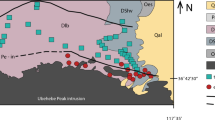Abstract
The relative growth rates of the three joint chains of silica tetrahedra and metal octahedra in the [100], [1̅10] and [1̅1̅0] directions within the mica layer (referring to the 1M unit-cell) seem to control the morphology of mica crystallites. Laths and fibers are the products of relatively fast growth along the [100] direction compared to growth along the [1̅10] and [1̅1̅0] directions. The (010) growth front in 1M micas with trans-octahedral vacancies exposes a pair of reactive OH ions that can form organic or inorganic complexes and ‘poison’ the growth on the (010) face.
Authigenic illite fibers in two sandstones with contrasting lithologies are found to have grown on mica or kaolinite cores. Illite fibers appear in single sets or in multiple sets, 120° apart. This texture seems to be related to the stacking sequence of the layers in mica or kaolinite in the core of these fibers.
Similar content being viewed by others
References
Bauer, A., Velde, B. and Gaupp, R. (2000) Experimental constraints on illite crystal morphology. Clay Minerals, 35, 587–597.
Champion, D. (1989) Etude des mechanisms de transformation des interstratifies illite/smectite au cours de la diagenese. Ph.D. thesis, University Paris XI-Orsay, France, 204 p.
Goldstein, J.I. (1979) Principles of thin film X-ray microanalysis. Pp. 83–120 in: Introduction to Analytical Electron Microscopy (J.T. Hren, J.I. Goldstein and D.C. Joy, editors). Plenum Press, New York and London.
Giiven, N. and Huang, W.L. (1991) Effects of octahedral Mg2+ and Fe3+ substitutions on hydrothermal illitization reactions. Clays and Clay Minerals, 39, 387–399.
Giiven, N., Hower, W.F. and Davies, D.K. (1980) Nature of authigenic illites in sandstone reservoirs. Journal of Sedimentary Petrology, 50, 761–766.
Giiven, N., Lafon, G.M. and Lee, L.J. (1982) Experimental hydrothermal alteration of albite to clays: preliminary results. Proceedings of the International Clay Conference 1981. Elsevier Scientific Publishing Company, pp. 495–512.
Hartman, P. (1972) Structure and morphology. Pp. 367–402 in: Crystal Growth—An introduction. North-Holland Publisher, Amsterdam.
Koenig, J.W. (1961) The Stratigraphie Succession in Missouri. State of Missouri, Department of Business Administration, pp. 13–31.
Lanson, B. and Champion, D. (1991) The I/S to illite reaction in the late stage diagenesis. American Journal of Science, 291, 473–506.
Lanson, B., Beaufort, D., Berger, G., Baradat, J., and La-charpagne, J.C. (1996) Illitization of diagenetic kaolinite-to-dickite conversion series: late-stage diagenesis of the lower Permian Rotliegend Sandstone reservoir, offshore of the Netherlands. Journal of Sedimentary Research, 66, 501–518.
Small, J.S. (1993) Experimental determination of the rates of precipitation of authigenic illite and kaolinite in the presence of aqueous oxalate and comparison to the K/Ar ages of authigenic illite in reservoir sandstones. Clays and Clay Minerals, 41, 191–208.
Small, J.S. and Manning, D.A.C. (1993) Laboratory reproduction of morphological variation in petroleum reservoir clays: Monitoring of fluid composition during illite precipitation. Pp. 181–212 in: Geochemistry of Clay Pore Fluid Interactions (D.A.C. Manning, P.L. Hall and C.R. Hughes, editors). Mineralogical Society/Chapman & Hall, London.
Small, J.S., Hamilton, D.L. and Habesh, S. (1992) Experimental simulation of clay precipitation in reservoir sandstones 2: Mechanism of illite formation and controls on morphology. Journal of Sedimentary Petrology, 62, 520–529.
Surdam, R.C., Boese, S.W. and Crossey, L.J. (1984) The chemistry of secondary porosity. Pp. 127–149 in: Clastic Diagenesis (D.A. MacDonald and R.C. Surdam, editors). American Association of Petroleum Geologists, Tulsa, Oklahoma.
Surdam, R.C., Crossey, L.J., Hagen, E.S. and Heasler, H.P. (1989) Organic-inorganic interactions and sandstone dia-genesis. AAPG Bulletin, 73, 1–23.
Thompson, T.L. (1991) Paleozoic Succession in Missouri Part 2. Ordovician System. Report of Investigations No. 70, Missouri Department of Natural Resources, pp. 69–78.
Triplehorn, D.M. (1967) Occurrence of pure well-crystallized IM illite in Cambro-Ordovician sandstone from Rhourde El Baguel field, Algeria. Journal of Sedimentary Petrology, 37, 879–884.
Wilson, M.D. and Pittmann, E.D. (1977) Authigenic clays in sandstones: Recognition and influence on reservoir properties and paleoenvironmental analysis. Journal of Sedimentary Petrology, 47, 3–31.
Author information
Authors and Affiliations
Corresponding author
Rights and permissions
About this article
Cite this article
Güven, N. Mica Structure and Fibrous Growth of Illite. Clays Clay Miner. 49, 189–196 (2001). https://doi.org/10.1346/CCMN.2001.0490301
Received:
Revised:
Published:
Issue Date:
DOI: https://doi.org/10.1346/CCMN.2001.0490301




